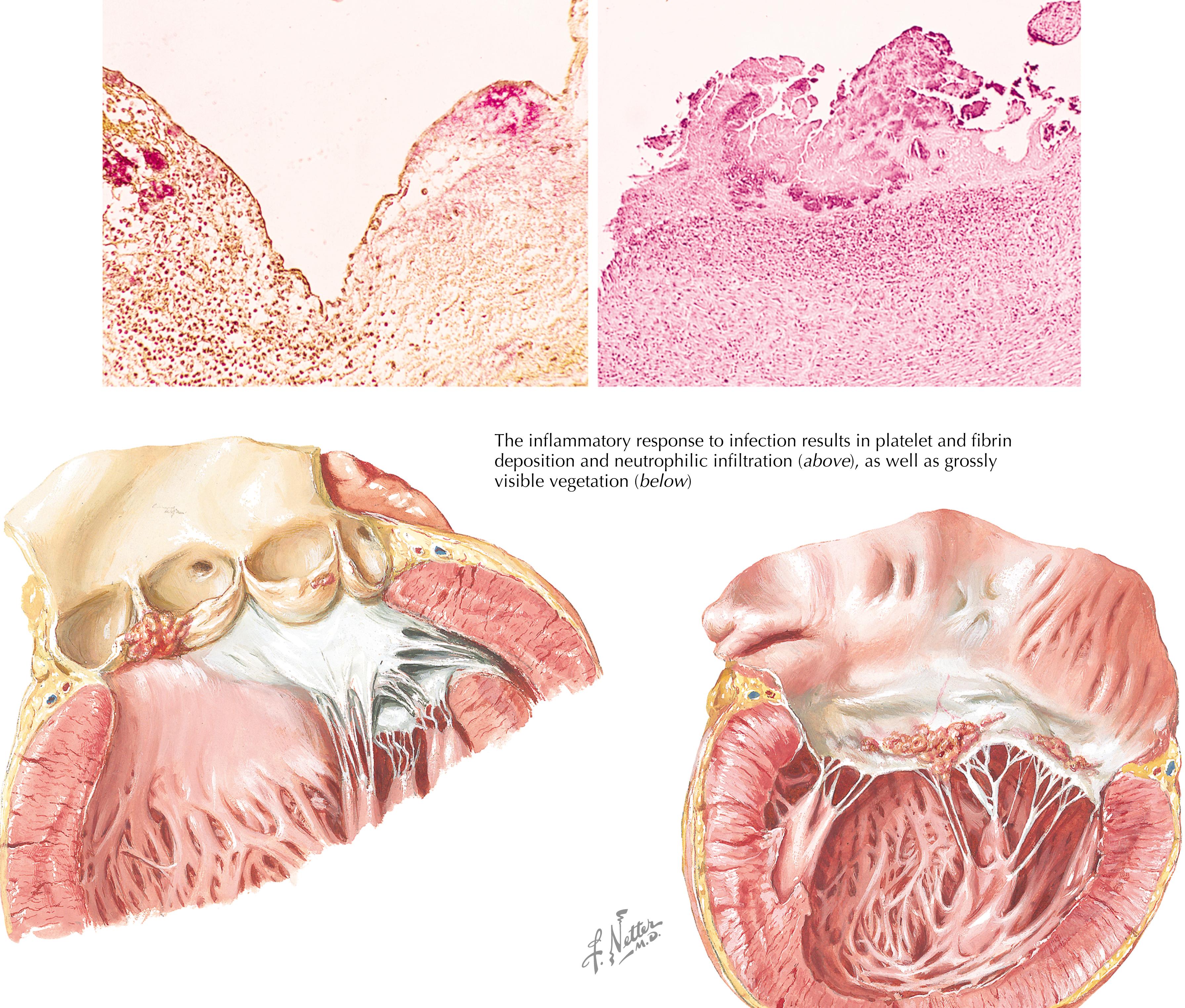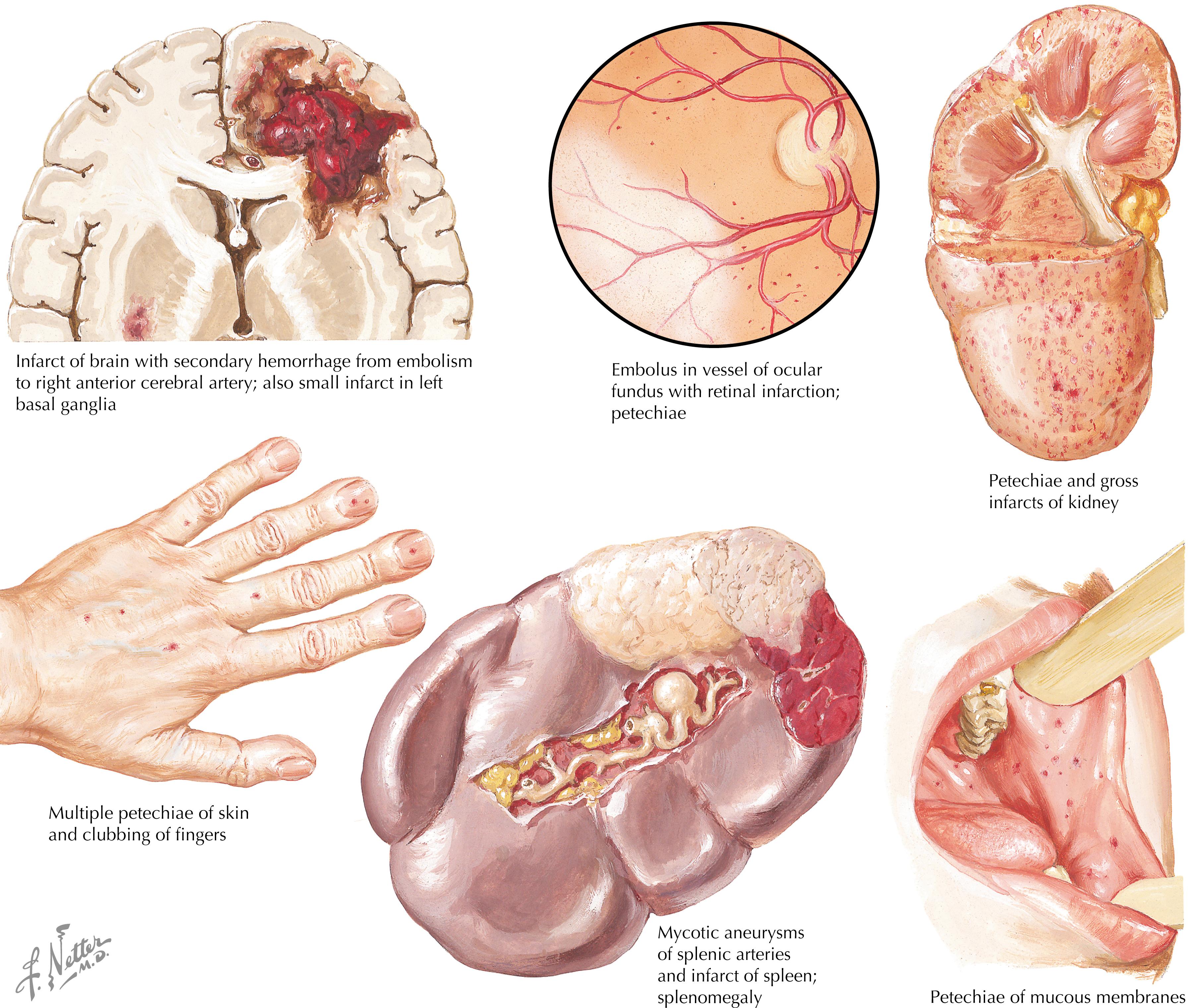Physical Address
304 North Cardinal St.
Dorchester Center, MA 02124
Infective endocarditis (IE) is a serious infection involving the interior of the heart, most commonly the heart valves. It is predominantly bacterial, most commonly caused by Staphylococcus aureus and streptococcal species. This chapter reviews the pathogenesis, clinical features, diagnosis, treatment, and prevention of this condition for both native and prosthetic valves. IE has always been a diagnosis that many physicians approach with anxiety and trepidation. The diagnosis can be elusive, the complications severe, and the treatment arduous. This has not changed significantly since the time of William Osler, who said that “Few diseases present greater difficulties in the way of diagnosis than malignant endocarditis, difficulties which in many cases are practically insurmountable” (from the Gulstonian Lectures on Malignant Endocarditis, 1885). Endocarditis and its many protean manifestations have long been known; since the mid-1700s they have been eloquently described by notable pioneers of medicine, including Morgagni, Virchow, Wilks, Janeway, Roth, and Bowman. The modern era has seen an increase not only in the risk of endocarditis but also in the ability to diagnose IE. Endocarditis is now likely to manifest much differently—more acutely and without the widespread stigmata observed in the past. However, despite great strides in the microbiologic isolation of causative organisms, echographic diagnosis, and antimicrobial treatment, the mortality remains high, contributing to the constant anxiety associated with this age-old disease.
A 28-year-old woman presented with fatigue and associated symptoms of arthralgias, malaise, and subjective low-grade fevers that had begun 2 weeks earlier. Initially a viral illness was suspected; further evaluation noted leukocytosis, mild thrombocytopenia, slightly elevated creatinine, microscopic hematuria, and an elevated sedimentation rate. Her rheumatoid factor was also elevated, prompting referral to rheumatology. Over the next few days, however, she noticed increased dyspnea with mild exercise and nonproductive cough. She presented to the emergency department with chills, fever and dyspnea. She had not injected drugs but had had a routine dental cleaning the month before the onset of her symptoms. On examination she was found to have a detectable systolic murmur, dependent rales on lung exam, and multiple small petechiae on her hands. Blood cultures grew Streptococcus mutans with a penicillin minimal inhibitory concentration (MIC) of 0.12 mcg/mL. A transthoracic echocardiogram noted a previously unknown bicuspid aortic valve with some aortic regurgitation. A subsequent transesophageal study revealed a mobile, oscillating 7-mm mass on the aortic valve leaflet. Chest x-ray showed pulmonary edema, and she had an elevated brain natriuretic peptide. Her neurologic examination was normal, but magnetic resonance imaging of her brain noted several lesions compatible with very small cortical and subcortical ischemic lesions without evidence of hemorrhage. After cardiovascular surgical consultation, early surgery for aortic valve replacement was performed on her fifth hospital day. A mechanical valve was placed successfully and, postoperatively, she was treated with 4 weeks of intravenous penicillin. Six months later, her exercise tolerance was back to baseline, she was anticoagulated on warfarin, and advised to have antibiotic prophylaxis before dental procedures.
COMMENT: This case demonstrates the nonspecific protean symptoms that may be early indications of endocarditis. The subacute presentation, although initially nonspecific, was eventually associated with many of the classic findings. S. mutans is a common agent of dental caries and a common cause of endocarditis after transient bacteremia. At the time of her eventual diagnosis, the patient was found to have congestive heart failure (CHF), which was an indication for early surgery. Appropriately, the magnetic resonance imaging (MRI) findings did not delay her surgery. Endocarditis associated with bicuspid aortic valves tends to occur in younger individuals who have a paucity of comorbid findings.
The pathogenesis of IE usually starts with an area of endocardial injury leading to platelet/fibrin deposition. Then, based on predisposing factors, when certain microorganisms enter the bloodstream, adherence occurs to the area of injury, as was demonstrated in a rabbit model of endocarditis by Durack and colleagues in 1972. Injury and infection most commonly occur on the valve leaflets but can also occur on or near congenital defects, chordae, chamber walls, prosthetic material, pacemaker leads, or any other endocardial location where favorable conditions exist. Microorganism adherence factors facilitate the initial colonization of the injured valve surface. Staphylococcus and Streptococcus species produce the majority of the human cases of IE because of their ability to adhere to damaged tissues of the heart. Conversely, Escherichia coli can be a common cause of bacteremia from urinary or gastrointestinal sources but is a rare cause of endocarditis because it lacks these adherence factors. The causes of native valve endocarditis (NVE) and their frequencies, as found by the International Collaboration on Endocarditis, are as follows: S. aureus , 31%; viridans group streptococci, 17%; coagulase-negative staphylococci, 11%; enterococci, 10%; Streptococcus gallolyticus (formerly S. bovis ), 6%; other streptococci, 6%; HACEK ∗
∗ Haemophilus parainfluenza , Aggregatibacter spp, Cardiobacterium hominis , Eikenella corrodens , Kingella spp.
, 2%; fungi/yeast, 2%; polymicrobial, 1%; other, 4%; and culture negative, 10%. The most common cause of culture-negative endocarditis is Coxiella burnetii , the etiologic agent of Q fever.
In 1978 Drs. Sheld, Valone, and Sande described the role of dextran, platelets, and fibrin in the adherence of streptococci to damaged endocardial tissue. Staphylococci use a variety of surface-bound adhesion components to bind to fibrinogen for colonization and to fibronectin for invasion. Certain coagulase-negative staphylococci such as Staphylococcus lugdunensis and Staphylococcus schleiferi possess a clumping factor that also binds fibrinogen and fibronectin as virulence factors. Enterococcus faecalis utilizes pili and collagen adhesion to facilitate adherence and aggregation. Once attached to the platelet-fibrin nidus on injured cardiac tissue, bacteria begin to multiply, increasing activation of coagulation cascade, attracting leukocytes, and grow in a further inflammation-promoting vegetation ( Fig. 36.1 ). This, in effect, buries bacteria deep within the mature vegetation, creating a biofilm environment. The unique behavior of microorganisms within this biofilm and the difficulty of antimicrobial penetration contributes to the treatment challenge of IE.

Patient factors that predispose to IE are those that create damage to the valvular surface, increase the incidence of bacteremia, or slow the immune response to infection. Endocardial and valvular pathology that can be seen with congenital processes such as bicuspid aortic valves or septal defects predispose to injury. Acquired valvular damage then may occur from atherosclerotic changes and rheumatic fever. Prosthetic heart valves of any type, prosthetic material used to repair congenital heart disease, and implantable cardiac devices are considered significant risk factors. Injection drug use leads to both valvular injury and frequently introduces bacteria into the bloodstream and therefore is a synergistic risk for IE. Hemodialysis likewise creates opportunity for frequent episodes of transient bacteremia owing to regular vascular access. Increasingly, exposure to health care procedures has become recognized as a risk factor. Diabetes mellitus and other diseases leading to phagocytic cell dysfunction are predisposing factors in some cases. Men tend to be predominant in most series, with ratios ranging from 3:2 to 9:1. The elderly have nearly five times the risk of younger individuals. This is likely because of the increased prevalence of degenerative valve disease, increased use of invasive procedures, implanted medical devices, atrophy of skin, and senescence of the immune system. Children with IE almost always have underlying congenital heart disease as the main risk. In both children and adults, a previous episode of IE is a notable risk factor for a subsequent infection.
Historically, endocarditis was a syndrome recognized by the chronic and diverse clinical findings depicted in the Netter illustrations. Now the rapid detection of bacteria with automated continuously monitored blood culture systems allow for much earlier diagnosis. Often, the first presenting sign of an eventual diagnosis of IE is a positive blood culture obtained in the evaluation of fever. Ninety-six percent of IE patients present with fever, and about 85% have an audible heart murmur, either new, worsening, or preexisting. Some patients still present with the classic manifestations of endocarditis after weeks of constitutional symptoms, depending on the virulence of the infecting organism. This subacute presentation is more common with viridans group streptococci, HACEK organisms, and Enterococcus . Endocarditis is often classified based on the acuity of the presentation and the type of valve: acute or subacute; native valve or prosthetic. The diagnosis should be suspected in any patient with risk factors, evidence of chronic inflammation (e.g., fever, chills, or night sweats) and a corresponding laboratory result of an elevated erythrocyte sedimentation rate, C-reactive protein, or rheumatoid factor with findings such as leukocytosis, anemia, and thrombocytosis. The distal physical findings of subungual splinter hemorrhages (8%), Janeway lesions (5%), Osler nodes (3%), and Roth spots (2%) occur rarely. More common clinical findings are worsening valvular dysfunction with resultant early CHF, conduction abnormalities including atrioventricular block, mycotic aneurysms, vascular embolic lesions ( Fig. 36.2 ) including embolic stroke, intracerebral hemorrhage, splenic or renal infarcts, septic pulmonary embolic from right-sided IE, petechiae of the conjunctivae, oral mucosa, or extremities, metastatic abscesses, septic arthritis, and vertebral osteomyelitis.

Part of the challenge of IE is that the diagnosis is usually made based on a constellation of clinical and laboratory findings without direct pathologic evidence of endocardial infection. In general, the diagnosis rests on the presence of an intravascular infection and evidence of endocardial involvement. The former is most commonly the growth of a typical organism on several blood cultures. Endocardial involvement is inferred by a new cardiac murmur, echocardiographic evidence of an endocardial vegetation, or the pathologic evaluation of a surgical specimen. Because there is no single definitive test result that is pathognomonic, syndromic diagnostic criteria have been used for many years. The first criteria were proposed in 1977 by Pelletier and Petersdorf. The most recently accepted criteria are often referred to as the “Duke criteria” and have been used in their modified state since 2000 ( Boxes 36.1 and 36.2 ). These criteria are more suited to left-sided NVE than to right-sided or prosthetic valve endocarditis (PVE) and must be utilized with significant clinical judgment, as their sensitivity and specificity for diagnosing IE are only around 80%.
Positive blood cultures
Microorganism typical of endocarditis from two separate blood cultures or
Persistently positive blood cultures drawn more than 12 hours apart or three or more positive cultures drawn over more than 1 hour or
Single positive blood culture for Coxiella burnetii or antiphase I IgG titer of greater than 1:800
Evidence of endocardial involvement
Positive echocardiogram for endocarditis
New valvular regurgitation (change in preexisting murmur is not sufficient for major criteria)
Predisposing heart condition or injection drug use
Fever (38°C or 100.4°F)
Vascular phenomena
Major arterial emboli, septic pulmonary infarcts, mycotic aneurysms, intracranial hemorrhage, conjunctival hemorrhages, Janeway lesions, and so on
Immunologic phenomena
Glomerulonephritis, Osler nodes, Roth spots, positive rheumatoid factor
Microbiologic evidence not included previously
Positive blood culture or cultures not meeting major criteria (not including single positive culture for coagulase-negative staphylococci not typically causing endocarditis) or serologic evidence of active infection with organism capable of causing endocarditis
Echocardiographic minor criteria eliminated
Become a Clinical Tree membership for Full access and enjoy Unlimited articles
If you are a member. Log in here